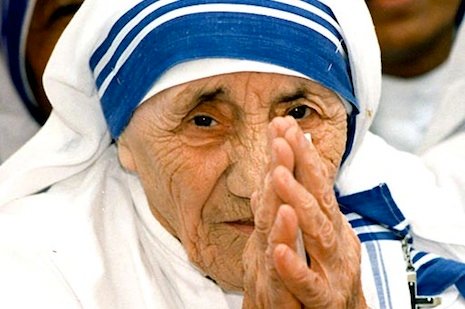Some things you may not have known about Mother Teresa
 Fifteen years may be less than an instant in celestial time, but here on earth it’s a lot of news cycles.
Fifteen years may be less than an instant in celestial time, but here on earth it’s a lot of news cycles.
Mother Teresa departed this Earth on September 5, 1997. What more can we say about the woman who became synonymous with love for the “poorest of the poor,” picking up a Nobel and tweaking the conscience of millions? What do we know about her now that we didn’t know then?
A lot, it turns out.
Here’s a quick Blessed Mother Teresa primer, emphasizing the stuff that you probably don’t know, some of which we only learned recently.
1. She was born a rich girl.
Born in 1910, Mother Teresa came from money – at least by the standards of her native Skopje, Macedonia. Her parents were so well-off that there was a local saying “as generous as the Bojaxhius.” (Her last name was Bojaxhiu; her given first name was Agnes.)
Agnes was cultured and well-educated: She wrote poetry and played the mandolin. Her family took in orphans and she tagged along as her mother went out to tend to the destitute. All of this challenges the notion of pre-saints as nasty, or no better than average, until God flicks a switch (think Paul, pre-Damascus).
In Agnes’ case, if God flicked a switch, he had clearly laid the circuitry carefully beforehand.
2. For a long time, it was hardly obvious that Teresa would end up who she became.
She emigrated to India to become a nun at age 18, but worked as a teacher another 17 years before receiving a series of startling visions and locutions (verbal communications) from Jesus. The experience, wrote her confessor at the time, was “continual, deep and violent.”
She later recalled it as a dramatic dialogue taking up pages: Jesus calls her “my little one” and demands that she “carry Me into the holes of the poor. I want Indian nuns … who would be my fire of love among the poor, the sick, the dying and the little children.” She hesitates. He asks impatiently, “Is your generosity gone cold?”
It had not. After two years spent convincing her local bishop, she was released from her previous vows and founded her Missionaries of Charity.
3. She changed our view of the poor.
“There are plenty of nuns to look after the rich and well-to-do people, but for my very poor, there are absolutely none,” Teresa wrote, describing communication she got from Jesus.
That seems a bit exaggerated. But Teresa redefined the concept of “working with the poor” in the modern age. For poor she substituted “poorest of the poor,” a new category with a corresponding moral imperative. She understood the word “with” as obliterating the line between benefactor and beneficiary, plunging her nuns deeply into the world of the slums.
As for “working,” Teresa combined case-by-case spontaneity with an organizational genius. In Calcutta she developed institutions – schools for poor children, homes for pregnant homeless women, orphans and lepers, and hostels for the dying – that became a template for her ministries the world over.
4. She was a marketing guru.
“Billions know about her compassion,” says evangelical megapastor Rick Warren. “But what is not so well known (were) leadership skills, evident in the multiplication of what she did to other parts of the planet.”
Teresa instinctively leveraged her growing renown, cultivating a United Nations of world leaders and donors and paving the way for the Missionaries. Four decades after her solo start in India, her order was in over 100 countries, making her one of the church’s truly great founders. “If there are poor on the moon, we will go there, too,” she joked – sort of.
5. She cultivated her celebrity.
Teresa was famous first in India, then worldwide, partly through the efforts of British journalist Malcolm Muggeridge and partly due to another gift. “The way she spoke to journalists showed her to be as deft a manipulator as any high-powered American public relations expert,” noted Irish rocker/philanthropist Bob Geldof.
That that gift seemed to be unconscious did not make it any less effective. After winning the Nobel Peace Prize in 1979, she became part of a Mt. Rushmore of greatest-generation religious icons – including Pope John Paul II, Billy Graham and the (relatively youthful) Dalai Lama – that has no successor generation.
Of them, Teresa attained the purest pop-culture status, capped by her touching friendship with then-Princess Diana of England. When the two died within a week of one another (Diana in a car wreck, Teresa by heart attack), a T-shirt immediately popped up showing both with halos.
6. Teresa had a long, dark night of the soul.
In 2007, a cache of newly released private letters introduced a startling unknown side to Teresa: a 39-year period, coinciding almost exactly with her Missionaries career, during which Jesus, previously so present, seemed utterly absent to her, in prayer and even in the Eucharist.
“The silence and the emptiness is so great,” she wrote, “that I look and do not see– the tongue moves (in prayer) but does not speak.”
Critics like the late Christopher Hitchens said the correspondence proved Teresa was just a “confused old lady.” But the letters were issued by her postulator, the Vatican-appointed advocate for her sainthood.
Her church regarded her perseverance in the absence of a sense of divine response as perhaps her most heroic act of faith. Both her torment and underlying faith were evident in another letter: “If I ever become a Saint – I will surely be one of ‘darkness,’” she wrote. “I will continually be absent from Heaven – to (light) the light of those in darkness on earth.”


 Votes : 0
Votes : 0









